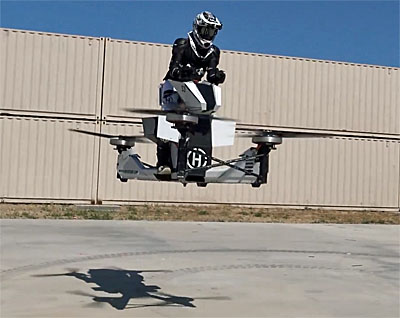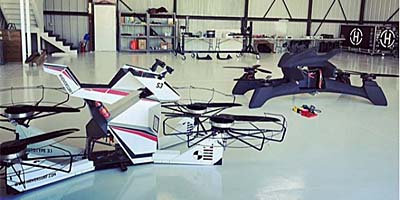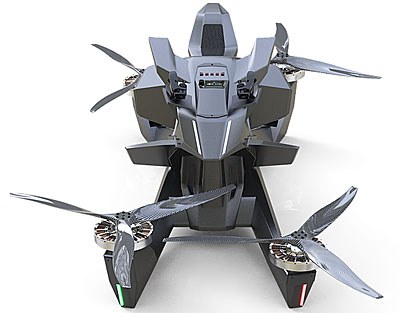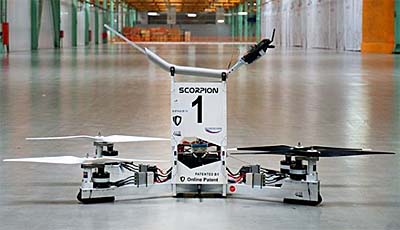 So far, at least three entries* in the multicopter sweepstakes qualify themselves as Part 103 ultralight vehicles. I’m guessing that lead FAA rule writer, Mike Sacrey, never envisioned this idea back in 1982 when he and his team created aviation’s least-regulated aviation sector. In those days, FAA had only recently moved away from requiring that such aircraft demonstrate foot launching.
So far, at least three entries* in the multicopter sweepstakes qualify themselves as Part 103 ultralight vehicles. I’m guessing that lead FAA rule writer, Mike Sacrey, never envisioned this idea back in 1982 when he and his team created aviation’s least-regulated aviation sector. In those days, FAA had only recently moved away from requiring that such aircraft demonstrate foot launching.
Mike would have needed a genuine crystal ball to foresee something like Scorpion 36 years ago. Let’s briefly put this in perspective — most readers had yet to buy their first computer; we were still 13 years away from the World Wide Web; it was a quarter century before the iPhone; even Light-Sport Aircraft were 22 years in the future.
 Had Mike written a regulation back then to include multicopters like Scorpion he would surely have been relocated to some remote post where his craziness would not be obvious.
Had Mike written a regulation back then to include multicopters like Scorpion he would surely have been relocated to some remote post where his craziness would not be obvious.
Yet multicopters seems to be everywhere and now, FAA has issued a formal letter saying, basically, “Yeah, it’s a Part 103 ultralight.”
Crazy, or Real? …but Fascinating
Our preceding article about a Lighter-than-Air LSA looks fairly tame compared to Scorpion. I know many readers are doubtful about either development …and that’s OK. Pilots being skeptical is a preservation instinct: don’t go fly any old thing that comes along; applying logic, analysis, and a serious measure of doubt may keep you alive.
 Some readers who read the earlier Scorpion article thought the close proximity of spinning props to the occupants legs was nuts (even if protections were in place). Others wrote that sitting above the blades was equally weird (although the first Kitty Hawk Flyer used a similar concept). I can understand all sorts of questions — or outright dismissal — but it appears multicopters are here to stay, even if their form may change radically in the years ahead.
Some readers who read the earlier Scorpion article thought the close proximity of spinning props to the occupants legs was nuts (even if protections were in place). Others wrote that sitting above the blades was equally weird (although the first Kitty Hawk Flyer used a similar concept). I can understand all sorts of questions — or outright dismissal — but it appears multicopters are here to stay, even if their form may change radically in the years ahead.
To their credit Hoversurf did consult FAA as this letter from Principal Maintenance Inspector Wilbert Robinson proves.
Hoversurf explains some of their ideas, “We have designed a monocoque frame created using different types of carbon fiber technology. The whole frame is made by a single element, which gives the stiffness of the structure … while reducing the weight by a factor of two compared to our previous aluminum model. … Dimensions of the hoverbike allow it to be rolled in a standard doorway while also having ability to take-off and land from an ordinary parking space. … [Scorpion] weighs (253 pounds) … reducing the weight of the frame … allowed us to install a more capacious battery. Our safe flight altitude is 16 feet above ground, but the pilot can adjust the limit to their comfortability. … Maximum speed is limited to 60 mph or 52 knots according to the requirements of the law.”

A few points need to be clarified:
- In one video the company representative speaks of “no limits,” saying you can fly as high as you like or as fast as you like. Of course, most readers know a Part 103 vehicle is limited to 55 knots or 63 mph. The website acknowledges this but the video was evidently produced before the Part 103 decision was made. The quote in the paragraph above shows company officials may have also backed away from the “fly as high as you like” comment.
- In a couple other videos, Scorpion’s price is quoted at $59,900, which less doubtful buyers might pay. Yet the website states the asking price at $150,000. At the latter figure, I imagine the number of buyers of an unproven vehicle will be very minimal (other than police or military buyers), though I could be wrong.
- What might be more workable and acceptable is a drone version that carries goods instead of a human. The website has information about this but that use is much less impactful than showing manned flight.
So, is Scorpion going places or destined to die on the vine? Only time will tell.
Here are a couple videos showcasing the flying machine:
* The three entries are Kitty Hawk Flyer, Opener BlackFly, and Hoversurf Scorpion


Has the FAA determined that the 24 knot “unpowered” stall speed rule for powered ultralights doesn’t apply to these eVTOL? Helicopters can autorotate power off; these can’t.
Hi Bill: You pose a valid question regarding how Part 103-qualifying eVTOLs meet that part of the reg. This may have been resolved with the Mosquito ultralight helicopter but it warrants more investigation. Stall and auto rotation should not be confused, though. Also, a multi-copter with robust, reliable software may be able to recover in the event one of its motors failing. More to be discovered about these aircraft, to be sure.
For those interested, a good many comments on this article may be found on the Light-Sport Aircraft Facebook page.